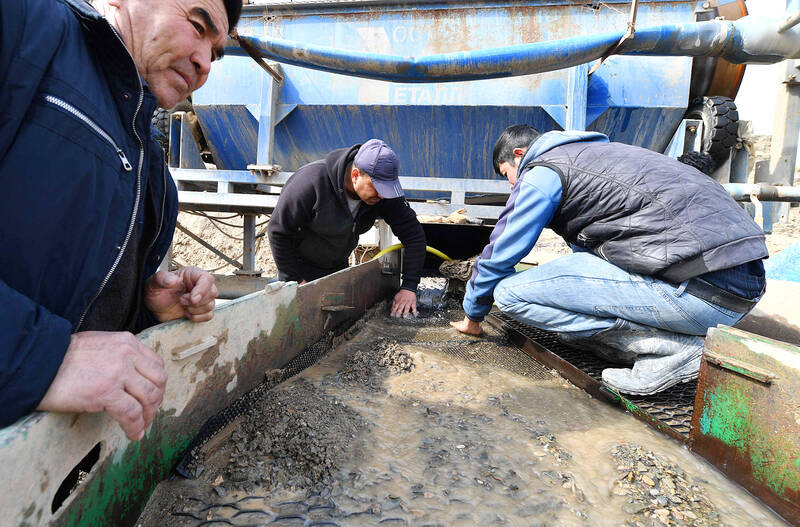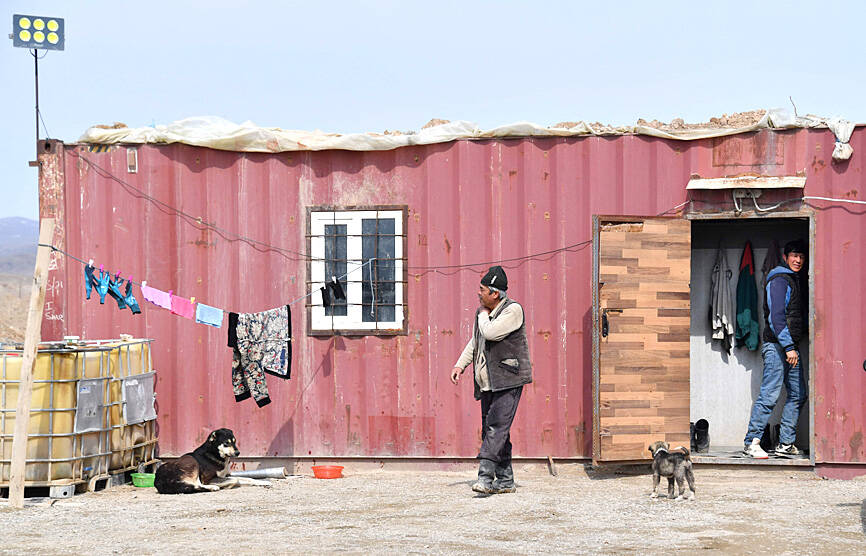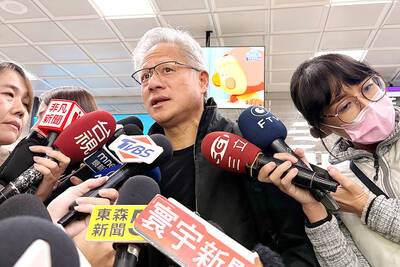Sifting through a grayish mixture of sand and pebble in the steppe of Uzbekistan, Khislat Ochilov was searching for gold.
He is one of hundreds of new prospectors trying to strike it rich in a modern-day gold rush in the Central Asian country, chock-full of the precious metal.
A right once preserved for state mining firms, recent regulatory changes designed to boost the economy mean anyone can hunt for gold.

Photo: AFP
Ochilov scanned the shiny flakes that appeared on his panning mat, submerged in a pool of water. Finally, he spotted a piece the size of a grain of rice.
“Not bad, though my record is 7g,” the 25-year-old said, while out in the Uzbek steppe, near the southwestern village of Soykechar.
Nearby, Sardor Mardiyev, 28, was hard at work digging through the earth in the vast Navoi Region, a district larger than Portugal.

Photo: AFP
He drives his excavator 12 hours a day, six days a week as part of a frenzy for the metal that officials hope will boost Uzbekistan’s output.
Last year, the country produced 110.8 tonnes of gold, putting it 10th place globally, and its central bank was the second-largest net seller in the world at about 25 tonnes, behind only Kazakhstan, World Gold Council data showed.
For Uzbek President Shavkat Mirziyoyev — who sees himself as a reformer opening up and liberalizing his country’s economy after years of isolation and centralization — it is not enough.

Photo: AFP
He has ordered gold production to be increased by 50 percent by 2030. The potential is there — only 20 percent of Uzbekistan’s subsoil has been explored to date.
Mirziyoyev, in power since 2016, has also called for gold bars weighing up to 1kg to be sold in the hopes of drawing more tourists to his landlocked Central Asian nation.
Zahit Khudaberdiyev, in his 30s, is among hundreds of entrepreneurs who have decided to try their luck since the regulation change. To join the gold rush he acquired the rights to a plot of land for three years at auction.
“Before 2019, we didn’t have the right to mine gold. Some did it anyway at the risk of death — it was dangerous,” Khudaberdiyev said.
His competition includes Kazakh and Chinese prospectors who secured neighboring plots.
If this one does not prove bountiful, he would look further afield, he said.
Behind Khudaberdiyev, trucks and diggers bustle with activity.
They churn up tonnes of rubble and can help scourers unearth a daily average of 12g to 15g, he said.
As he spoke, he had one eye glued to his phone, monitoring global gold prices.
This month, they climbed to a record high of US$2,200 per troy ounce (31.1g).
“The government decided to issue such plots for gold mining to provide work for the population,” he said.
The prospecting rush is providing an unexpected employment boon for a country where 20 percent of workers are forced to go abroad for employment, mainly to Russia.
Khudaberdiyev gave the example of his young employees, locals Ochilov and Mardiyev. Before he hired them, one was unemployed, the other a farm hand.
Now they earn 3 million to 4 million som US$237.88 to US$317.18 on average each month, Khudaberdiyev said — a decent salary for the region.
The new wave of gold miners are not allowed to do as they please with the gold they dig up. All of it must be funneled through the Uzbek central bank, which trades it for dollars on the global market.
The country’s growing economy depends on injections of foreign currency to support the national currency. The som has one of the lowest face values in the world, with US$1 worth 12,500 som.
In Soykechar, where farming remains a vital sector, not everyone is thrilled about the gold rush.
“Prospectors dig where we graze our cattle,” said Erkin Karshiev, a leading farmer in the region, about 500km southwest of the capital, Tashkent.
“Look how the last guys left everything,” the 66-year-old farmer said, motioning with frustration to holes a dozen meters deep.
Karshiev said he was “really afraid the animals will fall in,” but his multiple calls on the authorities to resolve the issue have thus far gone ignored.
“We only want one thing: for the gold miners to level the land by filling in the holes when they leave,” he said.

PERSISTENT RUMORS: Nvidia’s CEO said the firm is not in talks to sell AI chips to China, but he would welcome a change in US policy barring the activity Nvidia Corp CEO Jensen Huang (黃仁勳) said his company is not in discussions to sell its Blackwell artificial intelligence (AI) chips to Chinese firms, waving off speculation it is trying to engineer a return to the world’s largest semiconductor market. Huang, who arrived in Taiwan yesterday ahead of meetings with longtime partner Taiwan Semiconductor Manufacturing Co (TSMC, 台積電), took the opportunity to clarify recent comments about the US-China AI race. The Nvidia head caused a stir in an interview this week with the Financial Times, in which he was quoted as saying “China will win” the AI race. Huang yesterday said

Nissan Motor Co has agreed to sell its global headquarters in Yokohama for ¥97 billion (US$630 million) to a group sponsored by Taiwanese autoparts maker Minth Group (敏實集團), as the struggling automaker seeks to shore up its financial position. The acquisition is led by a special purchase company managed by KJR Management Ltd, a Japanese real-estate unit of private equity giant KKR & Co, people familiar with the matter said. KJR said it would act as asset manager together with Mizuho Real Estate Management Co. Nissan is undergoing a broad cost-cutting campaign by eliminating jobs and shuttering plants as it grapples

Japanese technology giant Softbank Group Corp said Tuesday it has sold its stake in Nvidia Corp, raising US$5.8 billion to pour into other investments. It also reported its profit nearly tripled in the first half of this fiscal year from a year earlier. Tokyo-based Softbank said it sold the stake in Silicon Vally-based Nvidia last month, a move that reflects its shift in focus to OpenAI, owner of the artificial intelligence (AI) chatbot ChatGPT. Softbank reported its profit in the April-to-September period soared to about 2.5 trillion yen (about US$13 billion). Its sales for the six month period rose 7.7 percent year-on-year

MORE WEIGHT: The national weighting was raised in one index while holding steady in two others, while several companies rose or fell in prominence MSCI Inc, a global index provider, has raised Taiwan’s weighting in one of its major indices and left the country’s weighting unchanged in two other indices after a regular index review. In a statement released on Thursday, MSCI said it has upgraded Taiwan’s weighting in the MSCI All-Country World Index by 0.02 percentage points to 2.25 percent, while maintaining the weighting in the MSCI Emerging Markets Index, the most closely watched by foreign institutional investors, at 20.46 percent. Additionally, the index provider has left Taiwan’s weighting in the MSCI All-Country Asia ex-Japan Index unchanged at 23.15 percent. The latest index adjustments are to